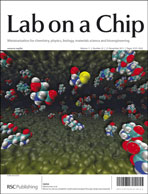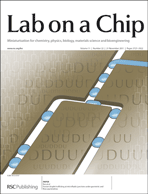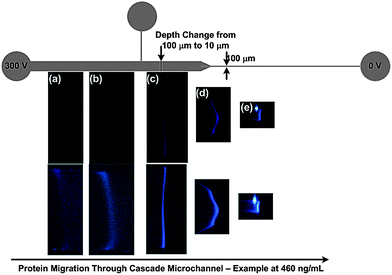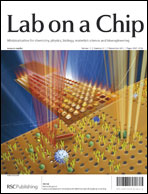_410_tcm18-209087.jpg)
Fixed channels direct the liquid perfluoropentane through a 7um wide orifice so that all of the droplets are the desired size for treatment
US scientists have developed a microfluidic device to manufacture droplets of a specific size at high speed for a cancer treatment called embolisation.
Embolisation involves blocking a blood vessel to restrict blood flow to a tumour. Gas embolotherapy is one such treatment, in which liquid droplets are introduced into a blood vessel and ultrasound is used to vibrate the droplets to produce enough heat to vaporise them. The liquid to gas phase change results in bubbles five to six times larger than the initial droplet, which can then block the blood vessel. Current methods to generate the droplets result in droplets of different sizes, forcing the therapies to require a higher activation power by ultrasound.
Now, droplets of a uniform size have been made by Abraham Lee at the University of California, Irvine, and co-workers. They have developed a microfluidic device to generate liquid perfluoropentane (PFP) droplets at high speed and in single file. The device is made of polydimethylsiloxane on a glass substrate and consists of fixed geometric channels designed to direct the liquid PFP through a 7µm wide orifice. The droplets were generated at a rate exceeding 100,000 droplets per second, were stable for weeks at room temperature and exhibited the desired size range for use in gas embolotherapy.
Joseph Bull, an expert in gas embolotherapy at the University of Michigan, US, states that this study has made a number of significant contributions to the field ‘including achieving a high production rate of lipid-encapsulated droplets and characterising the dynamics of droplet formation by high speed imaging’.
In the future, Lee plans to build a drug layer into the liquid PFP droplets to generate phase-change droplets for gas chemoembolotherapy. ‘Delivering a chemotherapeutic agent alongside our occlusive droplets should elevate local concentrations of the drug while minimising escape to the systemic circulation,’ he says. ‘We also plan to continue to push the limits in terms of rate and size of emulsion generation using droplet-based microfluidics,’ he adds.
High-speed, clinical-scale microfluidic generation of stable phase-change droplets for gas embolotherapy
David Bardin, Thomas D. Martz, Paul S. Sheeran, Roger Shih, Paul A. Dayton and Abraham P. Lee, Lab Chip, 2011
DOI: 10.1039/c1lc20615j
Article originally published in Chemistry World.

















 On the
On the  The
The  And on the
And on the 